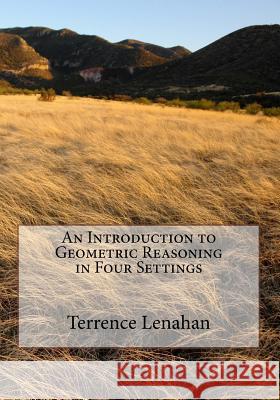An Introduction to Geometric Reasoning in Four Settings » książka
An Introduction to Geometric Reasoning in Four Settings
ISBN-13: 9781537457352 / Angielski / Miękka / 2016 / 250 str.
The book introduces the reasoning used to derive information about geometric objects. The development uses 3 basic steps and is repeated in 4 settings. First, the essential assumptions or axioms are identified from geometric activity like drawing on a page; next first-level properties are derived from the axioms; and finally 10 key theorems are proved based on the first two steps. Thus, inductive logic establishes a foundation and deductive logic hammers out the consequences. These steps are carried out for Plane, Solid, Spherical, and Hyperbolic Geometries. The first two Geometries, termed Euclidean, were initiated by Euclid almost 2400 years ago and added to by Euler, Monge, and others since then. The other two, termed non-Euclidean, have lines and figures confined to the surface of a sphere in Spherical Geometry and to a special hyperbolic plane in Hyperbolic Geometry. As a key difference of the non-Euclidean Geometries with Euclidean Geometry and with each other, there are no parallel lines in Spherical Geometry and there is a super-abundance of parallel lines in Hyperbolic Geometry. Looking at the same 10 theorems in 4 different settings provides a kind of controlled experiment that shows the effect of initial assumptions. After establishing basic properties of lines, angles, and circles in each setting, the book emphasizes triangles, or tetrahedra in Solid Geometry. Specific results include line and point concurrencies, the Pythagorean Theorem associated with each setting, areas and volumes, and properties of certain regular figures. The theory of similar triangles facilitates the proofs of several theorems in the Euclidean Geometries, but other means are required in the non-Euclidean ones. The final chapter illustrates how the previous approaches apply to trapezoids in Plane Geometry and their analogs in the other three settings. Over 100 figures, created from the Mathematica software system, help clarify the arguments used to verify results. Geometry is a gateway subject for those entering STEM fields, though the logic and rigor of the arguments has application to many fields. Also, geometry specifically calls for and fosters the ability to visualize situations and to represent them with figures, skills useful to designers of various products and enterprises. One indication that the study of geometry carries well beyond itself is the time Abraham Lincoln and Napoleon set aside to work on geometric questions. Napoleon even has a theorem named for him, which is part of the story here. A conclusion in the book, not usually noted, is that geometry is an experimental science. Questions that come up can be explored by drawing related figures to arrive at an answer or to test a conclusion. Accordingly, the reader is encouraged to approach this book with paper and pen at hand to test and explore. Working through the book in this way, the reader should acquire a thorough grounding in geometry and will have experience following, judging, and producing rigorous arguments, including some feeling for how to spot fallacies. With those skills, he or she will be well-equipped to go onto next steps, some of which are suggested at the end of the book.












